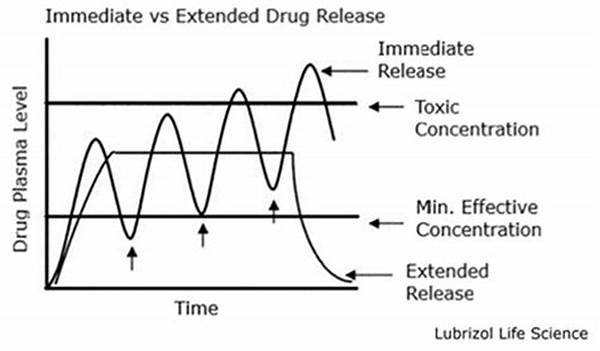In the realm of pharmaceuticals, the terms “immediate release” and “extended release” often surface, particularly when discussing medication formulations. The differentiation between these two types of drug release mechanisms is essential for healthcare professionals and patients alike. They dictate the manner in which a drug is released into the bloodstream, impacting efficacy, dosage frequency, and overall patient compliance. Understanding the distinctions between immediate release and extended release formulations can greatly assist in making informed decisions concerning medication regimens.
Read Now : Organ Healing Via Stem Cells
Understanding Drug Release Mechanisms
The immediate release vs extended release classification primarily reflects the drug delivery profile. Immediate release formulations are designed to disintegrate and release their active ingredient rapidly after administration, leading to a swift onset of action. These are often preferred when a rapid therapeutic effect is desired, or in acute settings. On the other hand, extended release formulations are engineered to dissolve slowly, providing a prolonged therapeutic effect and reducing the frequency of dosing. This type of release mechanism is beneficial for chronic conditions requiring consistent plasma concentrations over an extended period. The decision of using immediate release vs extended release medications plays a crucial role in individualizing patient treatment plans.
Clinical Implications of Immediate Release vs Extended Release
1. Onset of Action: Immediate release formulations offer a quick onset, ideal for acute conditions, whereas extended release provides a steady supply of medication over time.
2. Dosing Frequency: Medications with an immediate release profile often require multiple doses per day, whereas extended release can maintain efficacy with fewer doses.
3. Side Effect Profile: Extended release formulations may result in a lower incidence of side effects due to steadier plasma levels compared to immediate release formulations.
4. Patient Compliance: Extended release medications may improve patient adherence by reducing the dosing frequency compared to immediate release.
5. Therapeutic Consistency: Extended release ensures consistent therapeutic levels, mitigating the peaks and troughs associated with immediate release dosing.
Advantages and Disadvantages
Both immediate release vs extended release formulations present distinct advantages and limitations depending on the clinical context. Immediate release medications are advantageous for their rapid action, which can be critical in acute or emergency interventions. However, the necessity for frequent dosing can hinder patient adherence. Conversely, extended release medications offer improved adherence and consistent therapeutic effects but may take longer to achieve the desired clinical outcome. The choice between immediate release vs extended release should be tailored to the individual’s health needs, taking into consideration factors such as lifestyle, the specific condition being treated, and potential drug interactions.
Read Now : Advances In Tissue Engineering
Immediate Release vs Extended Release in Everyday Language
Alright, let’s break down “immediate release vs extended release” in simpler terms. Immediate release meds get to work quickly, great for when you’re in a pinch. Extended release? They’re the slow and steady type, awesome for keeping things smooth over the day. Need quick relief? Immediate’s your buddy. Want less pill popping? Extended’s the way to go. They both have their perks, it’s just about what you need at the time.
Patient-Centric Approaches
Medication Platforms and Patient Preferences
In the choice between immediate release vs extended release formulations, patient preference is a pivotal factor. Some patients prioritize immediate relief from symptoms and thus opt for immediate release options. However, those seeking convenience and adherence benefits may lean towards extended release options. The integration of patient feedback in clinical consultations enhances treatment outcomes and patient satisfaction. Healthcare providers should engage in open discussions with patients to explore the implications of immediate release vs extended release options, ensuring that the treatment aligns with the patient’s lifestyle and health priorities.
Drug Release Strategies
Pharmaceutical companies continually strive to improve drug delivery systems, making “immediate release vs extended release” a dynamic field of study. Immediate release strategies focus on rapid disintegration and absorption. In contrast, extended release methodologies explore advanced technologies like coated capsules and matrix systems to prolong drug action. The selection between these formulations should be informed by scientific understanding and patient-centric considerations. Effective communication between healthcare providers and patients is essential to harness the benefits of immediate release vs extended release formulations appropriately.
Summary of Immediate Release vs Extended Release
In summary, the discussion of immediate release vs extended release is pivotal in optimizing pharmacotherapy. Immediate release medications offer rapid symptom relief and are ideal in acute care scenarios. However, the frequent dosing schedule and potential for fluctuating drug levels can pose challenges. Extended release medications, with their sustained delivery, cater to chronic conditions, providing enhanced adherence and consistent therapeutic effects. Ultimately, the choice between immediate release vs extended release should be a collaborative decision, grounded in clinical evidence and aligned with the patient’s health objectives. Patients and healthcare providers must engage in transparent dialogue to assess the impact of these formulations on treatment efficacy and quality of life, ensuring that the most appropriate therapeutic strategy is selected.
